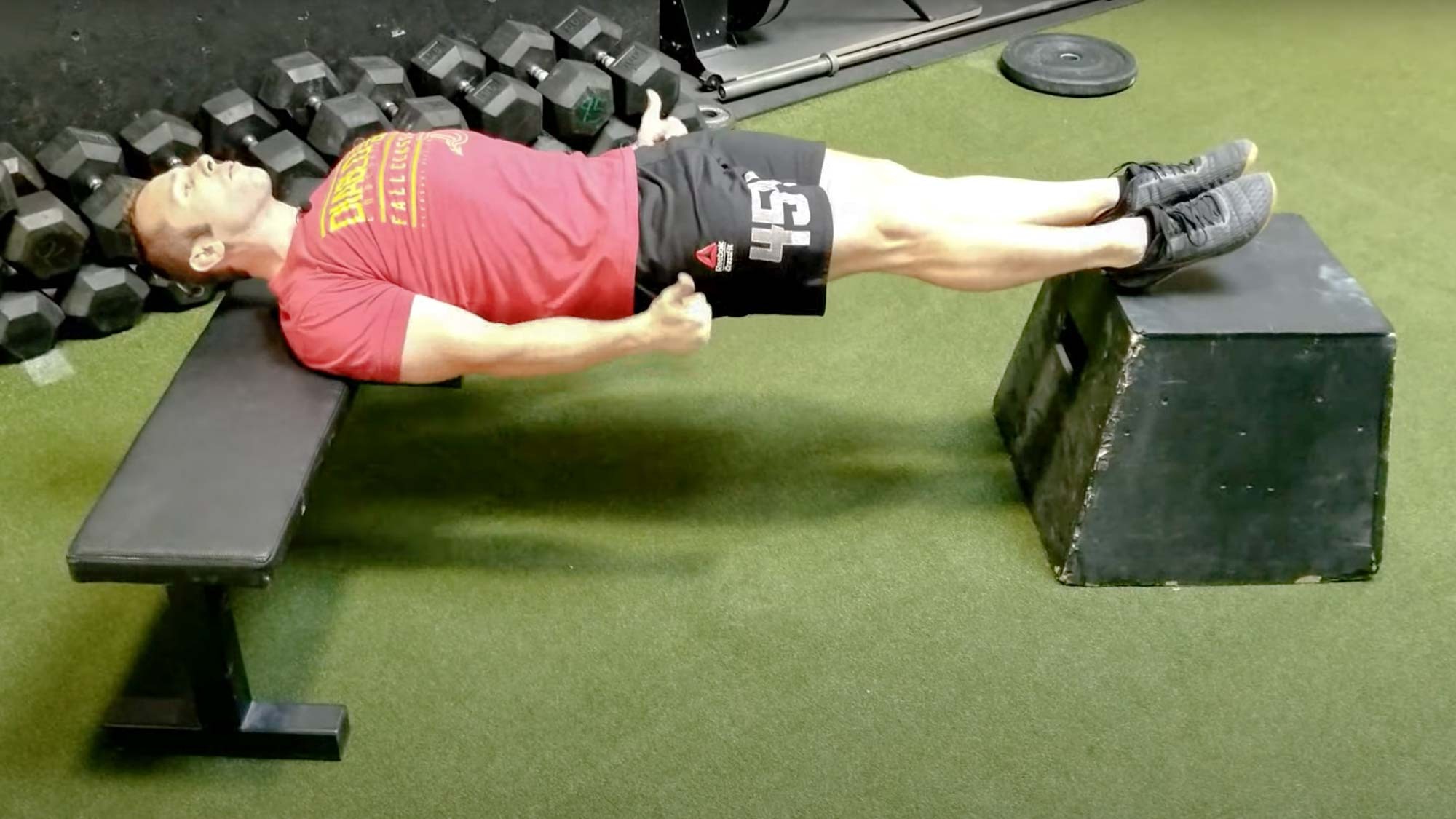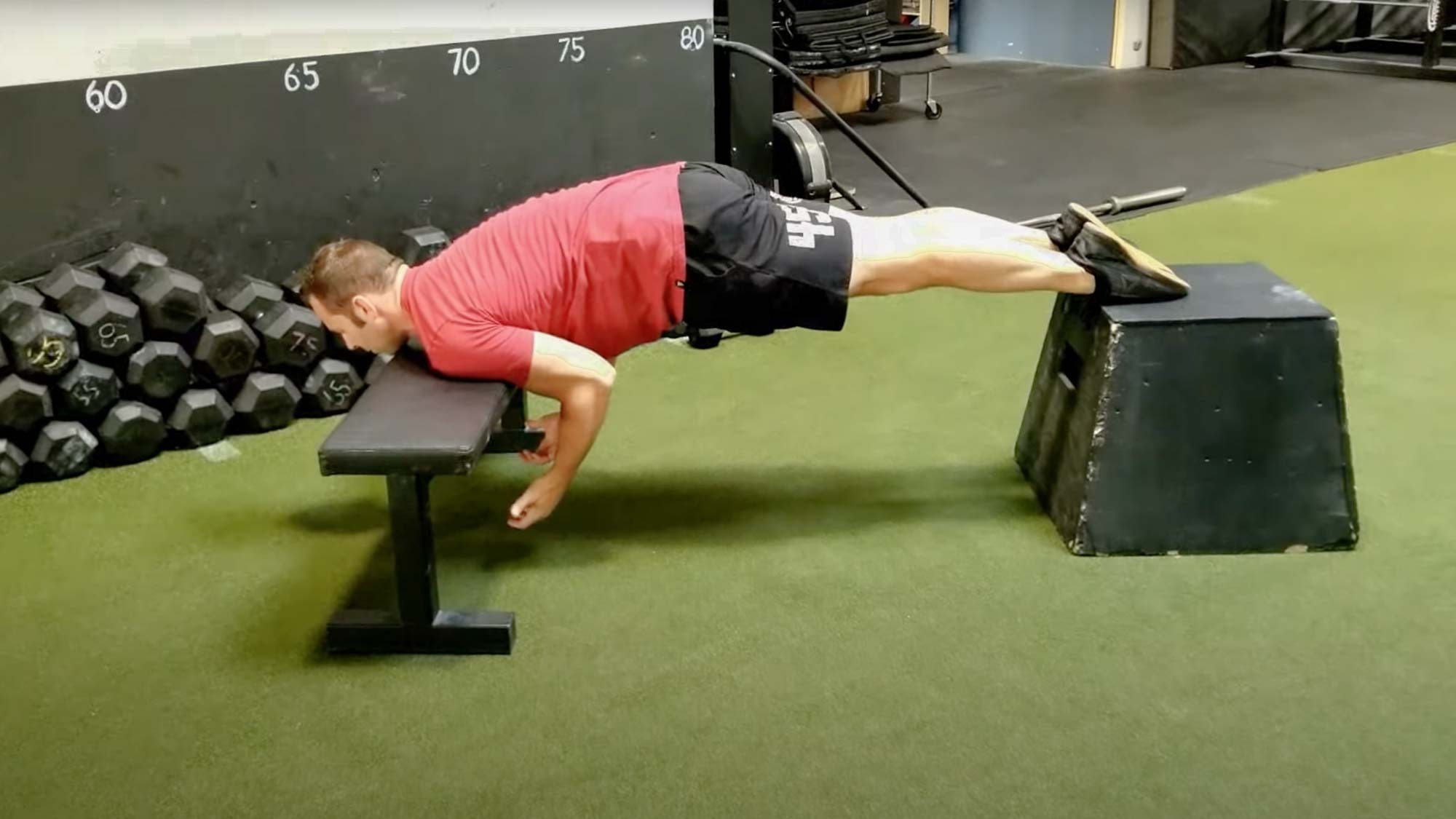
When we took on the Chinese plank in a recent fitness challenge, we didn’t expect to find so many benefits — here are three you can expect from trying this exercise.
The Chinese plank is a take on the reverse plank and one of the best plank variations out there. To do it, lay on your back in a supine position with your upper back and heels supported on a bench or box and the rest of your body unsupported, holding for as long as possible.
Find out the benefits of the Chinese plank, how to do it and three reasons to add this move into your exercise routine.
How to do the Chinese plank

Reverse the traditional plank exercise, take your arms away and elevate your body on a box. You’ve got a Chinese plank. Simple, right?
Not quite. The move is advanced. Here’s how to do it:
- Place two benches or boxes opposite each other
- Rest your shoulder blades on one bench, then place both heels on the other, laying flat and facing upward
- Tuck your chin toward your chest
- Point your toes and squeeze your core, glutes and quads, driving your hips upward and pressing through your heels
- Keep your spine neutral and avoid hyperextending your lower back
- Hold, and breathe.
Learn what happened when I did a 7-minute Chinese plank every day for a week and how to do the reverse plank to strengthen your lower back, glutes, hamstrings and abs here.
Reasons to try the Chinese plank, and the benefits for stronger core muscles
Here are three reasons to try this move.
Get instant access to breaking news, the hottest reviews, great deals and helpful tips.
1. Chinese planks strengthen your posterior chain muscles
It’s so much more than a core exercise.
The supine position of the Chinese plank transfers the load to the posterior chain muscles, meaning the muscle groups down the back of your body. The move builds strength in your shoulders, back, core, quads, glutes, hamstrings and calf muscles.
It activates the latissimus dorsi (lats), a large group of muscles that run down the sides of your back behind your arms, and the erector spinae — paraspinal muscles that hug and stabilize the spine.
The beauty of planks is compound contraction — you’ll need to squeeze as many muscle groups as possible to keep your hips up and spine neutral.
2. Chinese planks build muscular endurance
The plank variation is isometric, which means it holds the muscles under tension without lengthening or shortening through a range of motion. It’s a low-impact alternative for building strength and increasing muscular endurance, weight-bearing less on the joints. Isometric exercises are popular amongst people recovering from injury or beginners to strength exercises. You can learn more about isometric vs isotonic exercise here.
As you get stronger, you’ll be able to hold Chinese planks for longer periods, which is easy for testing your progress; it also utilizes a muscle-building technique called time under tension. TUT involves extending the total time a muscle spends under tension, tapping into a process called hypertrophy, which is how we build muscle. Find out about hypertrophy vs strength training in more detail here.
The benefits of building strength and muscle seem obvious, but endurance? Endurance refers to the ability of your muscles to contract and sustain exercise. That means performing exercise for longer, completing more reps, improving the strength of your muscles, boosting performance and increasing aerobic capacity.
3. Chinese planks are versatile
The core exercise is abundant with scaling opportunities.
Time
Practice holding for longer and longer as a measure of strength and endurance.
Go prone
The prone Chinese plank (see below) involves resting the fronts of your shoulders on the bench with your chin sitting over it, unsupported. Press your toes into the opposite bench and slightly lift your bum as you engage your core muscles.
Prone planks load the front of the body and demand core engagement to maintain the position. Alternating between the two provides a full-body torching.

Add weight
You could hold one of the best adjustable dumbbells to your hips or quads or practice holding a weight overhead. Start light and build foundational strength before adding weight, and remember to breathe throughout.
Position
Rest your elbows on the bench to activate more of your arms, shoulders, traps and rhomboids, or lift one leg off the bench at a time. Adopting a tripod position demands more muscle engagement to prevent losing position as you remove the support of one limb.
You could also move the benches further apart, pressing down through your shoulders and heels.
However you choose to attack the Chinese plank, remember to breathe. Learning to regulate your breath using abdominal breathing helps regulate the nervous system and strengthen the diaphragm, according to Harvard Health. It’s also a crucial core muscle that helps you breathe properly during exercise, delivering oxygen to your cells and muscles during and after workouts.
Learning to regulate your breath from a stress position also lowers blood pressure, whereas holding your breath could reduce blood flow to the brain. Not conducive to improving your health!
Start by holding the Chinese plank for 20-30 seconds, then slowly build. You could also add the exercise into various strength training programs.
More from Tom's Guide
- 7 best dumbbell shoulder exercises to try
- I did 50 standing oblique crunches every day for a week, here's what happened to my abs
- I did 50 butterfly sit-ups every day for a week, here's what happened to my abs

Sam Hopes is a level 3 qualified trainer, a level 2 Reiki practitioner and fitness editor at Tom's Guide. She is also currently undertaking her Yoga For Athletes training course.
Sam has written for various fitness brands and websites over the years and has experience across brands at Future, such as Live Science, Fit&Well, Coach, and T3.
Having coached at fitness studios like F45 and Virgin Active and personal trained, Sam now primarily teaches outdoor bootcamps, bodyweight, calisthenics and kettlebells.
She also coaches mobility and flexibility classes several times a week and believes that true strength comes from a holistic approach to training your body.
Sam has completed two mixed doubles Hyrox competitions in London and the Netherlands and finished her first doubles attempt in 1:11.
